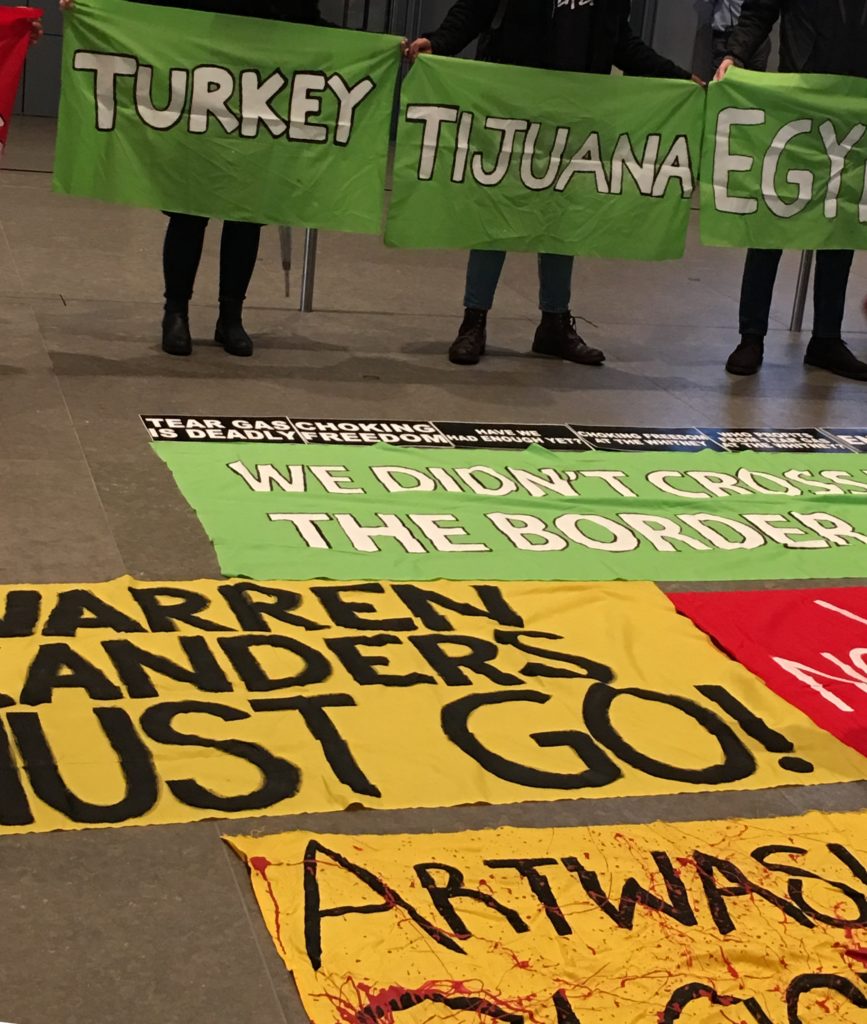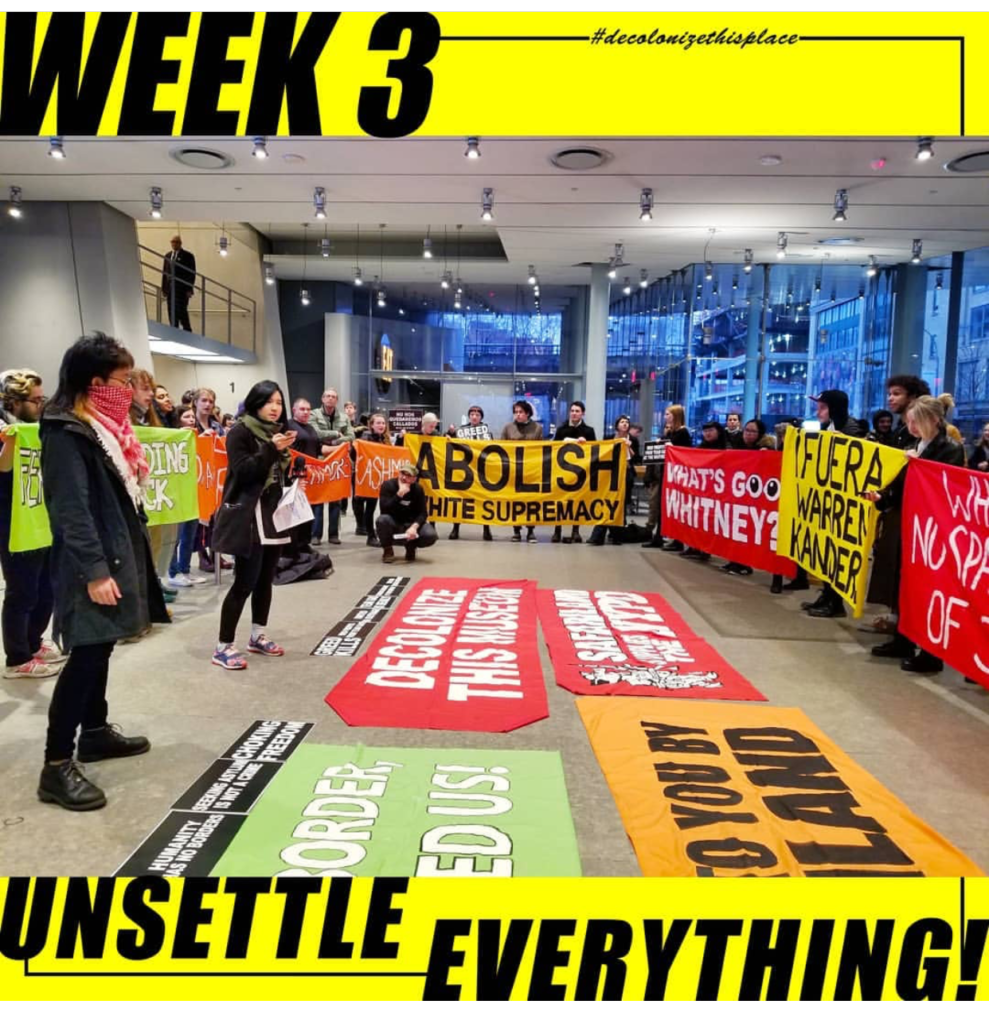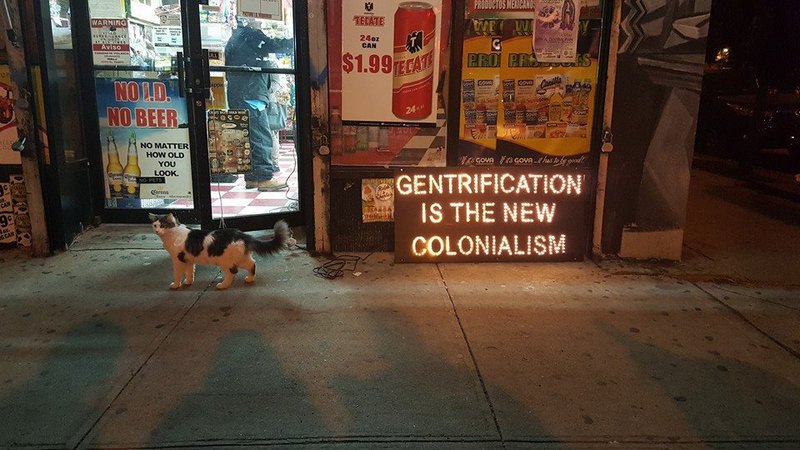Decolonize This Place is a protest organization started in 2016 described as “centering around Indigenous struggle, Black liberation, free Palestine, global wage workers and de-gentrification”. The organization has been getting considerable press since they began protesting at art museums and considered (from an ironic source) one of the changemakers to the art world for 2019.1
I attended and observed the third week of a continuing protest to remove Warren B. Kanders from the board of trustees at the Whitney Museum. Kanders is the majority owner and CEO of Safariland, a manufacturer of personal safety products, military defense, and law enforcement products including tear gas which had been used in the recent conflicts at the US-Mexico border. On this day of the protest, an open letter signed by over 120 artists, critics and academics was delivered to the Whitney and posted to the website, Verso, which was a notable increase in awareness since the protest started in December.2 Decolonize This Place plans at this point to continue their weekly protest until some sort of action or response is taken by the Whitney’s board.
When I arrived, the lobby of the museum was calm as the protesters were a bit late. The security guards were ready but relaxed and expecting the weekly assemblage, but I overheard their enthusiasm at the prospect that the protesters may not show. Once the organizers started to arrive, the larger group became apparent; they were asked to hold banners and gather in a circle to get started. The banners displayed the names of countries where tear gas has been utilized in recent conflicts including Standing Rock, Baltimore, and Egypt, for example, and also noted white supremacy and art washing. The final organized group looked like it was approximately 60 to 70 people. It appeared at this point that the protest would address wider issues than simply the Whitney board.

There was an MC for the group who started the dialogue and introduced the issues at hand – removing Warren Kanders from the board and the use of tear gas as a weapon of war. To get things started the he asked if there was anyone in the crowd that had signed the open letter and if so, would they stand up and say a few words. No one responded presumably because no-one was in the crowd, or, I could only assume that if some of the crowd was connected to any person within the museum, they may have been hesitant to speak up. Students from NYU picked up the mic at this point, addressing colonization in higher education. The students called out their own school and others including Columbia and Pratt. It was at this moment that I really couldn’t associate their cause to the main issue, but they did get the momentum started which led other speakers to address art washing, gentrification and the control of corporate money in all institutions.
The next question presented to the group was if anyone had experience with tear gas. This created an interesting shift in the energy of the crowd. First, a woman spoke up and explained she was in the military and had experience with tear gas in training drills. Next a man contributed his story about living in the West Bank and experiencing tear gas during a demonstration. His address to the group was about the use of tear gas as a weapon of war and a weapon to oppress. He went on to say that he respected what Decolonize was doing and wanted us to realize that the more we get used to oppressive behavior the more it desensitizes us. He stressed that the protesters work is important in keeping people aware of what tear gas is used for and that we should not be complacent. These comments brought the issue back around and this is where the protest started to get a bit heated.

It’s worthy to note that simultaneous to the protest was free Friday admission to the museum. Most of the general visitors did stop and look and some were interested (I believe the man who had lived in the West Bank joined in before his visit) and some were dismissive. I overheard some in the crowd think it was just about the current administration but didn’t seem to be interested generally. One unfortunate man was on his phone presumably poking fun at the protest, possibly he was in awe – maybe he had never seen such a thing in action – but he got called out for his privilege, which turned borderline aggressive but the protesters kept control.
The phone incident caused the momentum to increase further which brought the issues around to the ultra-rich supporting the arts and being the decision makers, which led to the topic of gentrification of the neighborhood and the funds it took to bring the Whitney to the meat packing district. This was an interesting point which I hadn’t considered because I remember the neighborhood representing a very different part of New York City and certainly not having high end vendors gracing the streets. I found this pertinent to the larger discussion in how the art world in general has contributed to gentrification under the guise of “revitalizing” the community.3 It is this gentrification and questionable funding that contribute to continuing colonization.

Observing protest, thinking about real change and watching the emotions it can bring up can be conflicting. Even though I support the cause, I still couldn’t help thinking about the privilege one has in this country to protest no matter what their cause or economic status. There is also the question of where funding would come from to make arts accessible and protected. I was able to speak informally with one of the organizers for Decolonize This Place, Ben, and ask him this question. His response was that arts institutions should have community involvement and should be publicly funded – similar to the principals discussed in Costanza-Chock’s Design Justice theory. Although I recognized his point, I still needed to mention that with the current structure of fundraising and where arts funding comes from in this country, we may have a long road to before we see this type of structure. Ben agreed but acknowledged that if there are open lines of communication when appointing board members to these institutions, there would be a “better way to vet the candidates and draw a red line on how funding is obtained”. If this were implemented there would be slow change, with the ultimate goal to avoid “toxic philanthropy”. Again, I couldn’t help but be divided on this point as the pragmatist in me sees money as force that is not easy to influence. That was until I spoke to one protester who, in her address to the group, asked us to consider the net worth of our subject, Warren Kanders. A man who’s worth $700 million through manufacturing defense products gets to decide on where the Whitney is built, what the Whitney will exhibit, and how the Whitney will pull in revenue all while not considering the community that resided there before and what served and built that community. It was then I realized that this is why we protest. While Kanders is not a decision maker in the administrations that carry out policies that utilize Safariland products, there is a value placed on these products by the larger society. Perhaps we need to question what and who we place our value on and consider when those values oppress communities with less power. Protest may not produce change immediately and our causes may be broad, but we need to get the conversations started, see how we feel about it in later generations and watch how that can evolve.
Resources
- https://observer.com/2019/04/arts-power-50-list/
- http://www.artnews.com/2019/04/05/warren-kanders-verso-books-open-letter/
- https://hyperallergic.com/350186/learning-from-decolonize-this-place/
COSTANZA-CHOCK Sasha, Design Justice: towards an intersectional feminist framework for design theory and practice